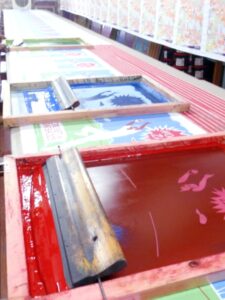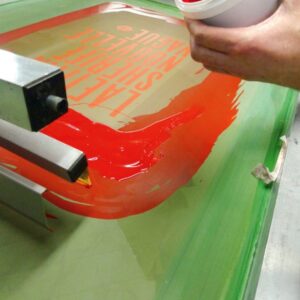Plastisol ink is a go-to for screen printers because of its durability, vibrant color range, and high-quality results on a variety of fabrics.
Whether you’re an experienced screen printer or a beginner, understanding Plastisol ink and its capabilities can greatly enhance your printing projects.
This guide will cover the essential aspects of Plastisol ink, including how it works, how to achieve the best results, and tips for sourcing it locally.

Table of Contents
Toggle1. Creating Soft-Hand Prints with Plastisol Ink
While Plastisol ink is known for its thick and plastic-like finish, it is possible to achieve soft-hand prints that are gentle and comfortable on the skin. Here’s how you can get the best of both worlds—durability and softness:
Opt for Low-Build Plastisol Ink: These inks are specially designed to provide a softer feel without compromising on print quality.
Control the Curing Process: The curing temperature is crucial. Proper curing ensures the ink bonds to the fabric, creating a long-lasting print without stiffness. Avoid over-curing or under-curing for optimal softness.
Add Soft-Hand Additives: These are mixed into the ink to reduce thickness and give a smoother, softer feel, while still maintaining opacity.
Choose the Right Screen Mesh: A mesh count between 160-230 ensures finer details and a softer, smoother finish, with less ink required for delicate prints.
By mastering these techniques, you can produce prints that are both durable and comfortable, perfect for premium apparel.
2. Best Methods for Printing Black Plastisol Ink on Dark Fabrics
Printing black Plastisol ink on dark shirts, especially black fabric, can be a challenge. However, using the right strategies can make your designs stand out vividly on dark garments:
Choose High-Opacity Inks: Regular black inks may not stand out on dark fabric. High-opacity black ink or specialized dark-fabric formulas will ensure visibility and vibrancy.
Underbase Technique: Start with a white underbase layer before applying black ink. This creates a bright backdrop that helps the black ink appear sharper and more vibrant after curing.
Double Printing: For an even richer black, you might need to apply a second layer of ink. This ensures deeper opacity and a more intense color.
Special Additives for Coverage: Certain additives enhance the opacity of black ink, allowing it to cover dark fabric more effectively without needing a second print.
Choosing the best method depends on your design and fabric type, but these techniques will help you get the clearest, most vibrant black prints on dark shirts.
3. How to Achieve Crisp White Plastisol Prints on White Shirts
Printing white Plastisol ink on white shirts requires a bit more finesse than it seems. To achieve bright, clean prints, follow these tips:
Use Opaque White Ink: Not all white inks are made equal. Choose an opaque white ink for superior coverage that pops even on white fabrics.
Thin Your Ink for Precision: Thinning the white ink slightly helps to achieve smoother prints and sharp edges, especially for detailed designs.
Layering for Full Opacity: One layer of white ink might not be enough. After curing the first layer, apply a second one for richer, more opaque white prints.
Use Fine Mesh for Detail: For crisp, clean details, a fine mesh count ensures precision, particularly when printing intricate artwork or text.
By following these steps, your white prints on white shirts will look vibrant and sharp, with even coverage and high detail.
4. Plastisol Heat Transfers: How to Use Plastisol Ink for Transfers
Did you know that Plastisol ink is also excellent for heat transfers? Heat transfers are perfect for printing on specialty items like hats, bags, or hard-to-print fabrics. Here’s how to do it:
Prepare the Artwork: The design must be mirrored before printing on transfer paper for heat transfer applications.
Print with Plastisol Ink: Use regular Plastisol ink (or heat transfer-specific formulations) to print the design onto transfer paper.
Cure the Print: As with screen printing, the ink must be fully cured before being transferred. Make sure it’s dry to avoid smudging.
Press the Transfer: Finally, use a heat press to apply the transfer onto the fabric. The heat and pressure will bond the ink to the fabric, ensuring a durable design.
Heat transfers with Plastisol inks are known for their color brilliance, durability, and versatility, making them ideal for custom projects on various materials.
5. Why Plastisol Inks are Ideal for Screen Printing
There’s a reason Plastisol ink has been a favorite in the screen printing world for years. Here are a few of the benefits that make it a top choice for many printers:
Long-lasting Durability: Once cured, Plastisol prints are highly resistant to fading and damage, even after multiple washes.
Vivid Colors: Plastisol inks are known for their rich, opaque colors, especially on darker fabrics.
Beginner-Friendly: Plastisol ink is relatively easy to work with, making it an excellent choice for both professionals and those new to screen printing.
Versatile Applications: Plastisol can be used on many fabric types, including cotton, polyester, and blended materials, making it ideal for a wide range of projects.
6. What are Low-Cure Plastisol Inks?
Low-cure Plastisol inks cure at a lower temperature than standard Plastisol, and they come with several advantages:
Quicker Production Times: Since low-cure Plastisol inks cure faster, production time is reduced, increasing efficiency in busy print shops.
Energy Savings: The lower curing temperature requires less energy, reducing overhead costs for large-scale operations.
Softer Finish: Low-cure Plastisol provides a softer print feel, which is highly desired for apparel such as t-shirts.
Low-cure Plastisol is an excellent choice for those looking to streamline their production and reduce costs while still producing high-quality prints.
7. Finding Plastisol Ink Near You
Looking to purchase Plastisol ink locally? It’s important to source from reliable suppliers who offer a variety of products suited to your printing needs. Many suppliers also offer custom formulations for specific requirements, so it’s worth checking out your local distributors or manufacturers.
Ensuring that you choose high-quality Plastisol ink will directly impact the success of your printing project, whether it’s for custom apparel or promotional items.
Conclusion
Plastisol ink is one of the most versatile, durable, and vibrant options available for screen printing. Whether you’re printing on dark fabrics, creating heat transfers, or producing soft-hand prints, Plastisol ink can help you achieve exceptional results. By understanding the right techniques and choosing the appropriate ink for your needs, you’ll be able to elevate your screen printing projects to a professional level.
Looking for Plastisol ink near you? Take the time to find trusted local suppliers, and you’ll be set to create high-quality prints that stand the test of time.

